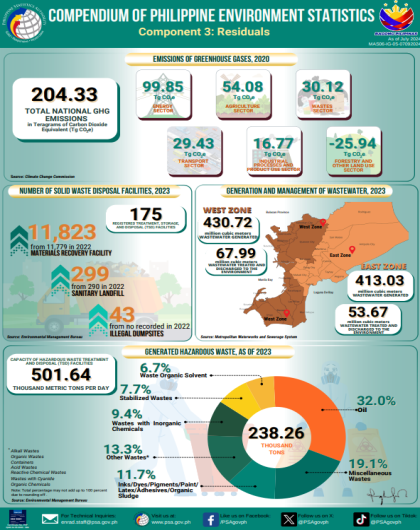The Mineral Accounts of the Philippines aims to provide information on the stocks and changes in stocks of four metallic mineral resources in the country, namely: nickel, gold, copper, and chromite. These accounts allow for the monitoring of the sustainability of the extraction of these valuable yet depletable natural assets. The compilation adheres to the System of Environmental-Economic Accounting 2012 Central Framework (SEEA-CF).
Monetary Asset Accounts
The valuation of the mineral assets of the Philippines uses the Net Present Value Approach as recommended by SEEA-CF using a 10 percent discount rate.1

The total monetary value of Class A nickel, gold, copper, and chromite reserves reached PhP 378.04 billion in 2021. This is a 32.3 percent increase from the PhP 285.81 billion recorded value in 2020. Class A nickel reserves increased in monetary value by more than 50 percent from PhP 121.60 billion in 2020 to PhP 186.62 billion in 2021. The value of Class A gold reserves reached PhP 143.45 billion in 2021, a 12.7 percent increase from PhP 127.32 billion in 2020. The value of Class A copper reserves increased by 30.9 percent from PhP 35.43 billion in 2020 to PhP 46.38 billion in 2021. In 2021, Class A chromite reserves was valued at PhP 1.60 billion, a 9.5 percent increase from PhP 1.46 billion in 2020. (Tables 1.6, 2.6, 3.6, and 4.6)
The total resource rent2 of the four mineral resources contributed 0.2 percent to the Gross Domestic Product (GDP) of the Philippines in 2021, amounting to PhP 44.87 billion. (Tables 5.1 and 5.2)
Physical Asset Accounts
The Class A nickel reserves of the Philippines decreased by -4.8 percent from 498.68 million metric tons (MT) in 2020 to 474.49 million MT in 2021. From 492.75 thousand kilograms in 2020, Class A gold reserves declined by -3.6 percent or 475.14 thousand kilograms in 2021. The Class A copper reserves also recorded a decline by -1.6 percent from 3.31 million MT in 2020 to 3.26 million MT in 2021. Meanwhile, a decrease by less than one percent was recorded in Class A chromite reserves from 35.98 million MT in 2020 to 35.97 MT in 2021. Class A reserves are commercially recoverable mineral resources which are confirmed to be economically viable by a defined development project or operation.3 (Tables 1.1, 2.1, 3.1, and 4.1)
DENNIS S. MAPA, Ph.D.
Undersecretary
National Statistician and Civil Registrar General
1 Recommended by National Economic and Development Authority. https://www.neda.gov.ph/wp-content/uploads/2017/01/Revisions-on-ICC-Guid...
2 Resource rent = Net operating surplus – Return to produced assets – Interest expense
3 United Nations Framework of Classification (UNFC) 2009

